Toshiba launched the MK01GRRB series of enterprise hard drives at the end of last year. The 2.5" 15,000RPM 6Gb/s SAS drives are available in 147GB and 300GB capacities, making the MK01GRRB the fastest enterprise hard drive Toshiba offers in the 2.5-inch form factor. Toshiba isn’t just about spindle performance with this family of drives though, they’ve also spent quite a bit of engineering to improve power consumption, further driving a better total cost of ownership.
The MK01GRRB drives utilize a power state that reduces drive spin in idle states, lowering overall power consumption. Of course the benefits of power use include reduced heat dissipation, cooling requirements, etc. while driving better drive reliability. Toshiba offers the drives in 147GB and 300GB capacities, in addition to a self-encryption (AES-256) option which is signified with an R instead of a B at the end of the product name. The SED option offers enhanced security without giving up drive performance. All four versions of the drive include a 5-year warranty.
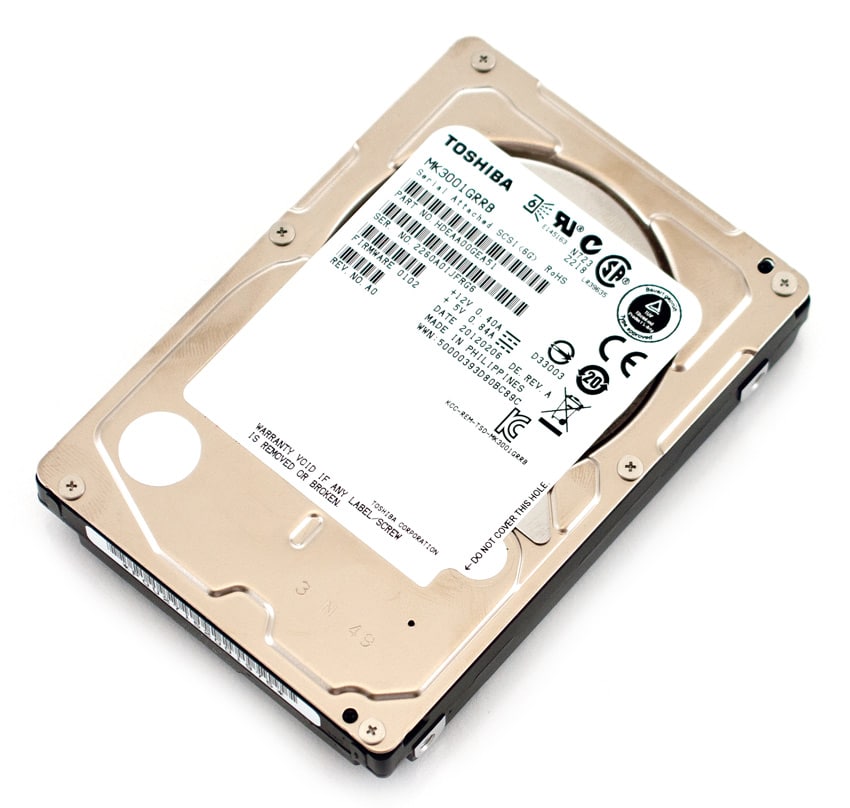
Toshiba MK01GRRB Specifications
- Capacities
- 147GB
- Standard – MK1401GRRB
- SED – MK1401GRRR
- 300GB
- Standard – MK3001GRRB
- SED – MK3001GRRR
- 147GB
- 6 Gb/s SAS
- Rotational Speed: 15,000 RPM
- Track-to-track Seek 0.35ms typ. (Read), 0.2ms typ. (Write)
- Average Seek Time 3.0ms typ. (Read), 2.7ms typ. (Write)
- Average Latency 2ms
- Buffer Size 32MB
- Power Requirements
- Spin up (start) Power 2V +/- 5%: 1.2A (peak), 1.5A (peak < 100us), 5V +/- 5%: 1.0A (peak)
- Read/Write Power: 8.7W
- Active Idle Power: 4.3 watts
- Dimensions (W) x (D) x (H) 69.85 mm (2.75") x 100.45 mm (3.95") x 15 mm (0.59")
- Weight 220 g
- Environmental
- Temp – Operating 5° to 55°C (41° to 158°F)
- Humidity – Operating 5% to 95% RH
- Vibration – Operating 0.6mm (5 to 20Hz) 9.8 m/s² (1.0G) (20Hz to 300Hz)
- Shock – Operating 980 m/s² (100G) max, 1ms
- Altitude – Operating 3,048 m
- Acoustics (idle): 3.3 bels
- Mean Time Between Failures (MTBF) 1,600,000 hours
- Error Rate (seek) 1 x 107
- Error Rate (unrecoverable) 1 x 1016
- Warranty – Limited Warranty 5 years (from date of purchase)
Design and Disassembly
The Toshiba MK01GRR-series hard drive has a very utilitarian design, which is not uncommon for enterprise hard drives or even SSDs. The design is two-tone with a silver top cover and a black-painted body with silver accents where metal is ground off when machining its very precise shape. The top cover includes basic information, including the model name, date of manufacturer, firmware revision, revision number, and its various certifications.
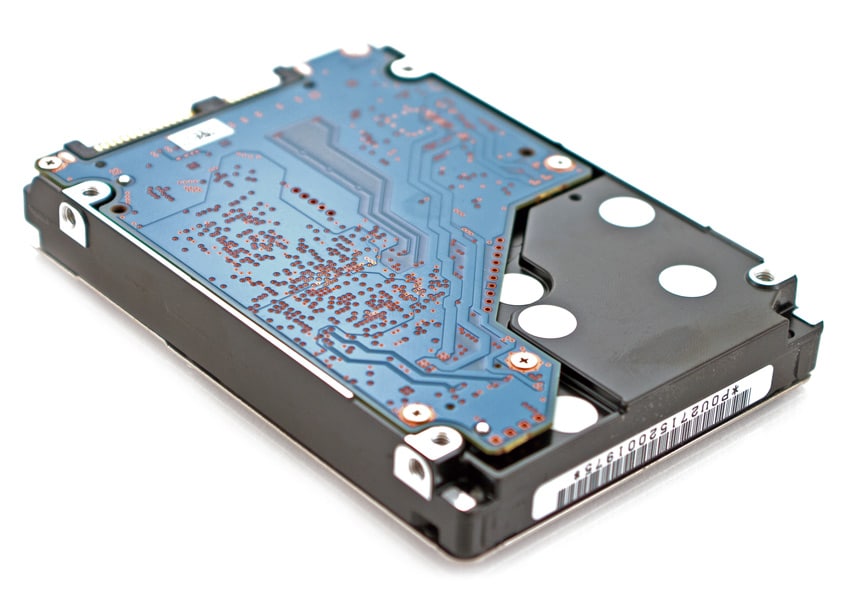
The drive makes use of nearly all the available space in the 2.5-inch wide, 15mm tall form-factor. The circuit board is nearly flush with the bottom surface, with all components inward facing. This style of design allows the heat-generating components to dissipate thermal energy into the case of the drive and dissipate into the airflow that is drawn over the drive when installed in a drive bay.

The front of the drive features a standard SAS data and power connector, with no visible service pins.
After removing an assortment of precision Phillips head screws, the circuit board can be lifted off the body of the drive. This exposes the Marvell SAS controller, 32MB Winbond DDR2 module, and the thermal pads used to draw heat away from the motor controller and controller.
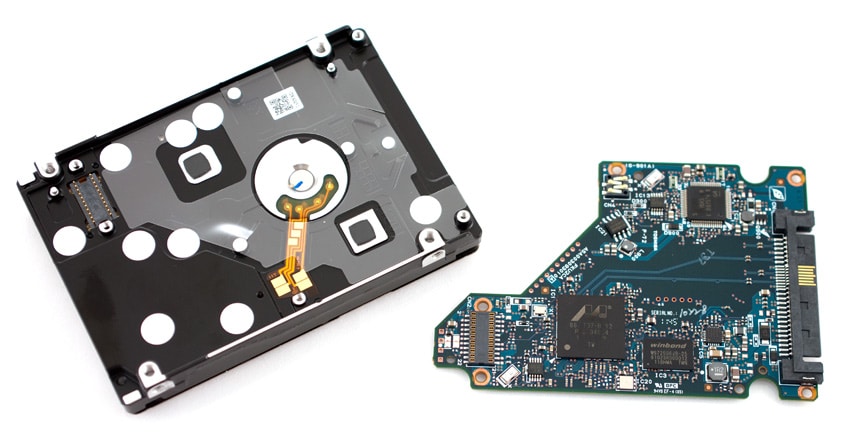
Enterprise Synthetic Benchmarks
The Toshiba MK3001GRRB is a 300GB 2.5-inch 15,000RPM hard drive with a SAS interface. The comparables used for this review include the following enterprise hard drives: Seagate Cheetah 15K.7 (300GB, 3.5-inch, 15,00RPM, SAS), Hitachi Ultrastar 15K600 (300GB, 3.5-inch, 15,000RPM SAS), the Toshiba MBF2600RC (600GB, 2.5-inch, 10,000RPM, SAS), and the Seagate Savvio 10K.4 (600GB, 2.5-inch, 10,000RPM, SAS). All enterprise hard drives are benchmarked on our enterprise testing platform based on a Lenovo ThinkServer RD240. All IOMeter figures are represented as binary figures for MB/s speeds.
Our first test looks at the speed in a sequential write environment with large block transfers. This particular test uses a 2MB transfer size with IOMeter, with 4k sector alignment and measures performance with a queue depth of 4. Toshiba doesn’t specify sequential data transfer speeds for the MK3001GRRB, only latency figures.
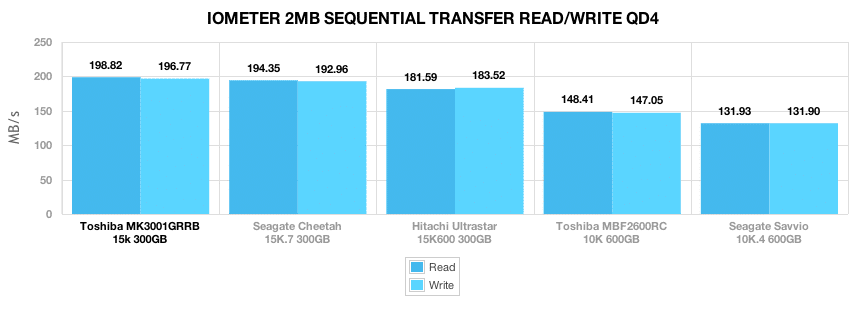
The Toshiba MK3001GRRB offered the fastest sequential transfer speeds, measuring 198.82MB/s read and 196.77MB/s write. Compared to the 10,000RPM Toshiba MBF2600RC, this is a 33% increase in transfer speed.
Moving to a random access profile, but still maintaining a large block transfer size of 2MB, we start to see how performance varies in a multi-user environment. This test keeps the same queue depth level of 4 that we used in the prior sequential transfer benchmark.
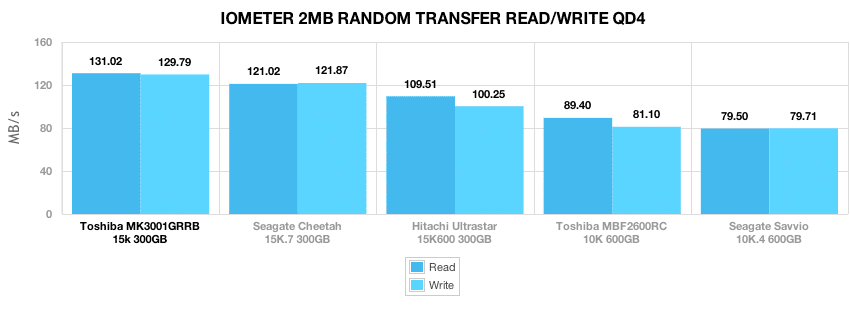
In a large-block random transfer test, the Toshiba MK3001GRRB again offered the highest performance out of the bunch of enterprise hard drives we tested. It peaked with a 131.02MB/s read speed, and a write speed measuring 129.79MB/s.
Moving to an even smaller random access transfer size of 4K, we get closer to the packet size that might be found in a heavy random access environment such as a server setting with multiple VMs accessing the same array. In the first test we look at 4K read and write performance at a queue depth of 1.
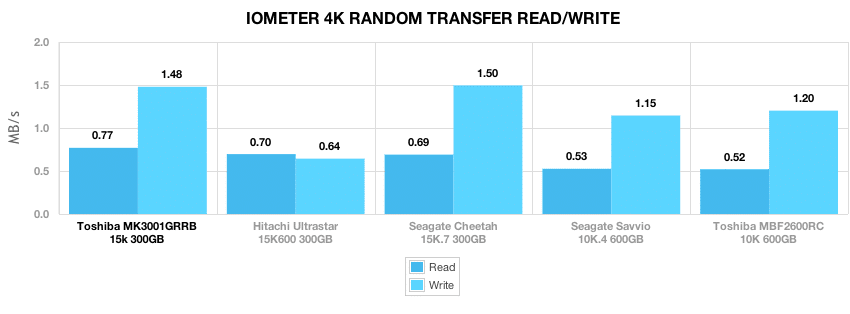
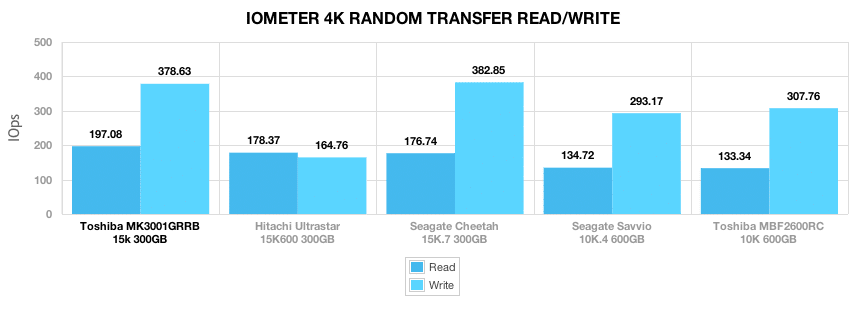
At a queue depth of 1 the Toshiba MK3001GRRB offered great performance, measuring 0.77MB/s read or 197 IOPS and 1.48MB/s read or 379 IOPS.
Our next 4K test looks at the expanded read and write performance and how it scales from a queue depth of 1 to a maximum of 64.
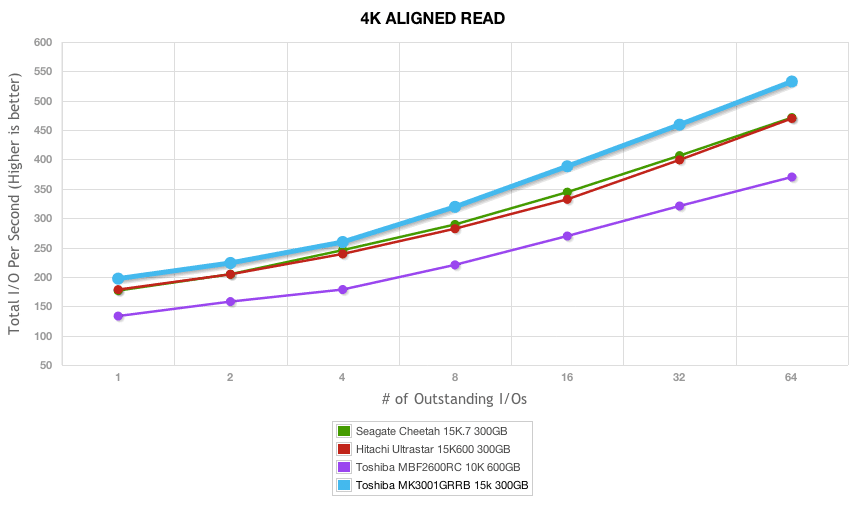
In a ramped 4K random read setting the Toshiba MK3001GRRB led the pack, and scaled very well up to a queue depth of 64. At its highest level it measured 533 IOPS read.
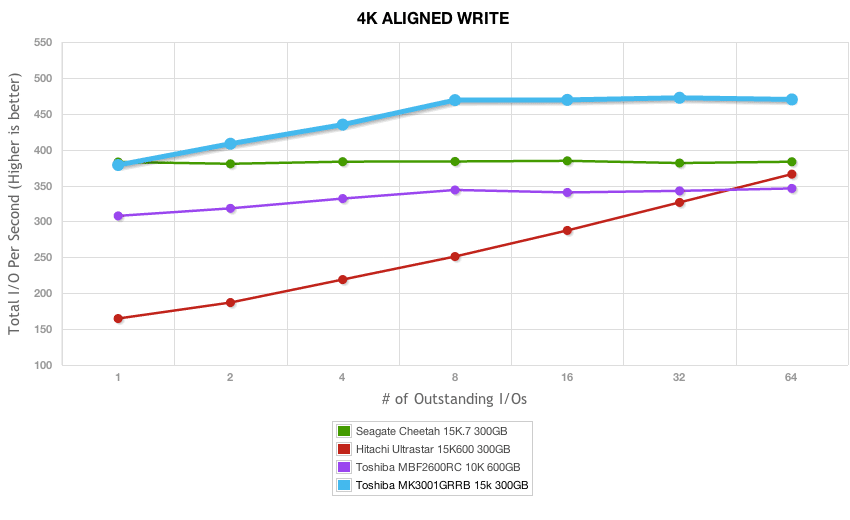
In our ramped 4K write test the Toshiba MK3001GRRB offered strong performance off the bat, scaling well up to a queue depth of 8 where it leveled off. It peaked with a speed of 472 IOPS write.
While throughput is a good metric to measure hard drive performance, another key area of interest is around average and peak latency. Higher peak latency figures can mean certain requests can backed up under heavy continuous access. We tested the latency of each hard drive at a queue depth of one. The Toshiba MK3001GRRB came in towards the top with an average latency of 2.64ms. Peak latency was in the higher range, as with the 10K Toshiba model we tested, measuring 376ms.
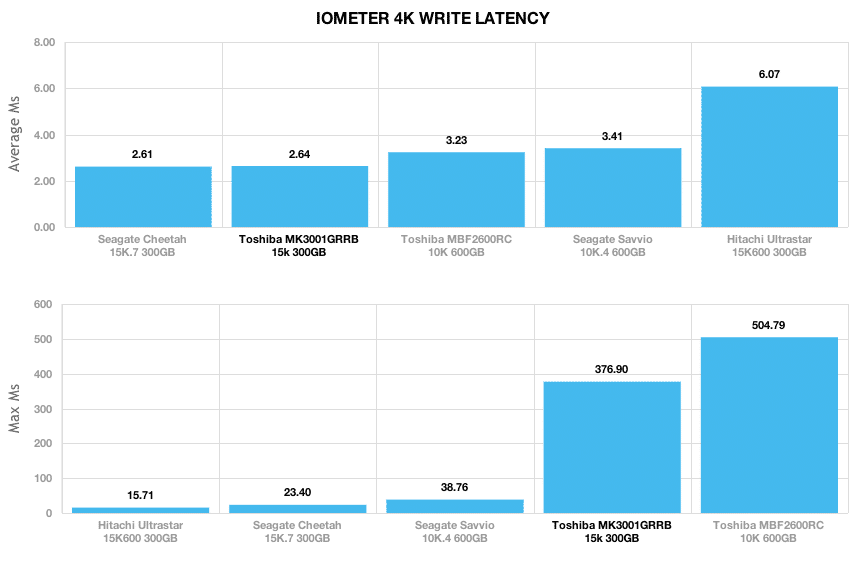
Our last series of synthetic benchmarks compare the enterprise hard drives in a series of server mixed-workloads with a queue depth of ranging from 1 to 128. Each of our server profile tests has a strong preference towards read activity, ranging from 67% read with our database profile to 100% read in our web server profile.
The first is our database profile, with a 67% read and 33% write workload mix primarily centered on 8K transfer sizes.
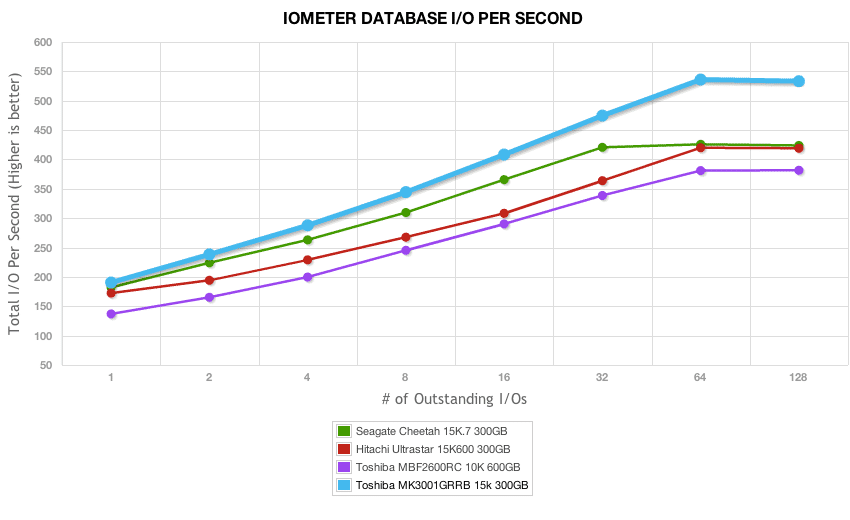
The Toshiba 15K SAS hard drive offered the strongest mixed workload performance out of the bunch, and scaled to a queue depth of 63 before leveling off at 536 IOPS.
The next profile looks at a file server, with 80% read and 20% write workload spread out over multiple transfer sizes ranging from 512-byte to 64KB.
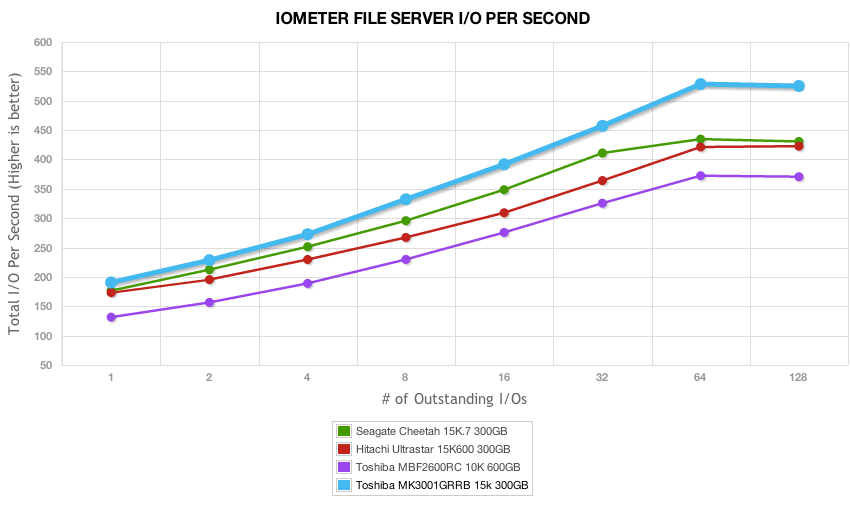
In our fileserver workload the Toshiba MK3001GRRB again maintained a strong lead over the competing drives, peaking at a queue depth of 64 with a combined transfer speed of 528 IOPS.
Our web server profile is read-only with a spread of transfer sizes from 512-byte to 512KB.
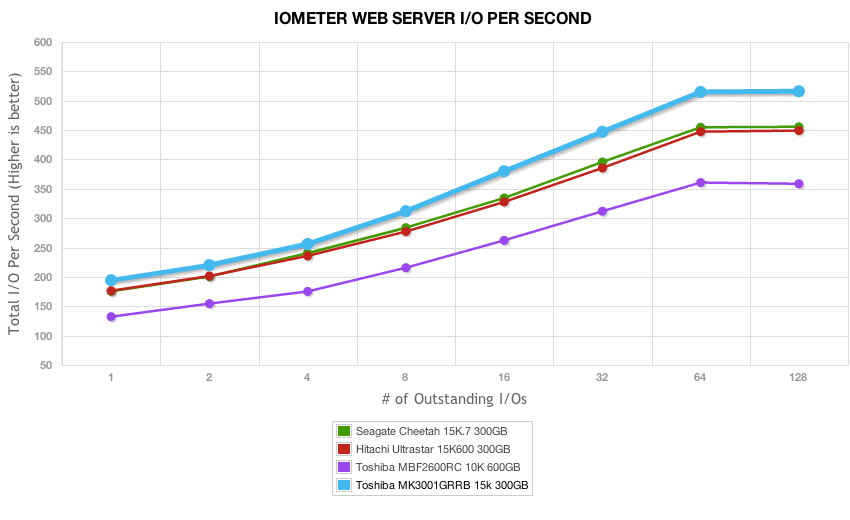
In a read-only webserver setting the 15K 2.5-inch Toshiba peaked at 514 IOPS, well above either of the 3.5-inch 15K competitors.
The last profile looks at a workstation, with a 20% write and 80% read mixture using 8K transfers.
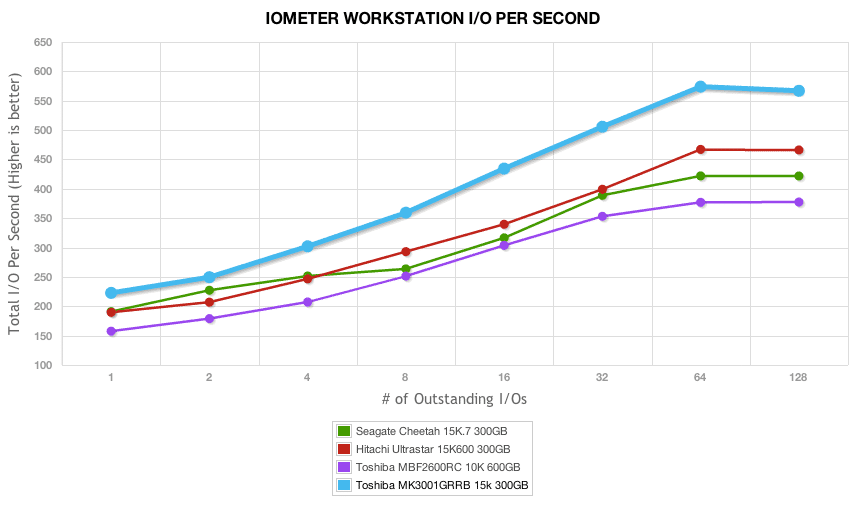
In our last mixed workload covering a workstation profile, the Toshiba MK3001GRRB showed its strongest performance lead, measuring 573 IOPS at a queue depth of 64.
Power Consumption
When it comes to choosing drives for the datacenter or other densely-packed storage environment, performance isn’t the only metric companies are interested in when looking at SSDs or hard drives. Power consumption can be a huge deal in certain cases, so it makes sense that you would want to know how a drive would perform under a constant workload. To that end we measured power consumption of the Toshiba MK3001GRRB in sequential read and write modes, random 4K read, as well as idle and startup. Toshiba claims an average read/write power usage of 8.7 watts and an idle rate between 4.3-4.5 watts depending on which mode it is in.

In our testing the Toshiba MK3001GRRB actually came in below the rated specifications in terms of power usage. In a range of activity ranging from sequential write to random read, we measured power values between 6.33 watts and 7.78 watts. Idle power measured 4.04 watts with startup peaking at 10.89 watts.
Conclusion
The Toshiba MK01GRRB firmly plants its stake in the ground for hard drive performance superiority in the enterprise. While the trend for many is a transition to SSDs and flash for high performance storage, the enterprise still has 10K and 15K legacy systems to support as well as new small form factor deployments to consider where hard drives still have advantages. Our review Toshiba MK3001GRRB clearly indicates hard drives still have upside as well, as the drive dominates throughout the review, taking home almost all the #1 positions in benchmark testing.
The drive particularly excels in highly random traffic, as seen in our expanded queue depth 4K random I/O tests as well as our mixed workload tests. At low queue depths the drive doesn’t start too far apart from the other 10,000 or 15,000RPM enterprise models, but one the outstanding I/Os start piling on, the Toshiba MK3001GRRB handles the added load with ease. In every single mixed workload the 15K Toshiba HDD lead the pack by a wide margin. The only area where performance could be slightly improved is peak write latency, which measured far above the other enterprise hard drive we tested, except the 10,000 RPM Toshiba model.
In terms of power consumption, the Toshiba MK3001GRRB came in slightly under the official specifications and measured just over 4 watts at idle. Overall with the lower power consumption further improving the TCO of fast platter drives, Toshiba continues to show the market that 15K hard drives still make sense in certain scenarios with improvements to their latest generation model.
Pros
- Fastest sequential and random large-block transfer speeds
- Best small-block random I/O performance at high queue depths
- Excellent power consumption
Cons
- High peak latency in our 4K random write test
Bottom Line
The Toshiba MK01GRRB shows that high-performance hard drives aren’t quite ready to hand over the reins to flash when it comes to high performance enterprise storage. It’s the fastest 15K hard drive we’ve tested to date and offers improved power consumption, showing there’s still room for innovation in the hard drive space.
Toshiba MK01GRRR at Amazon.com



 Amazon
Amazon